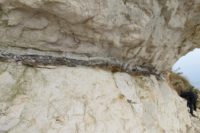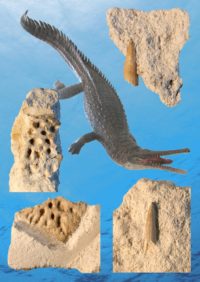 The white chalk cliffs of Stevns Klint on the Danish island of Zealand are geological marvels, one of the best exposed Cretaceous-Tertiary boundaries in the world, complete with a visible record of the ash cloud created when the Chicxulub meteorite crashed off the coast of the Yucatán Peninsula 65 million years ago and caused the greatest mass extinction of all time. A thin grey line of clay divides the white chalk at the bottom from the line above it; it is a literal boundary line marking the end of the Cretaceous.
The white chalk cliffs of Stevns Klint on the Danish island of Zealand are geological marvels, one of the best exposed Cretaceous-Tertiary boundaries in the world, complete with a visible record of the ash cloud created when the Chicxulub meteorite crashed off the coast of the Yucatán Peninsula 65 million years ago and caused the greatest mass extinction of all time. A thin grey line of clay divides the white chalk at the bottom from the line above it; it is a literal boundary line marking the end of the Cretaceous.
The cliffs are replete with fossils documenting plant and animal life before the meteorite and their recovery afterwards. Many are embedded in the cliff face and the constant erosion makes it a very productive site for fossil hunters.
 Amateur geologist Peter Bennicke has made several important finds there, most recently two teeth and two armour plates from a 66-million-year-old crocodilian. The plates, also known as osteoderms, are sheets of bone under the skin of crocodiles that are coated with horn-like material. They’re what give crocodiles that armor-like plating down their back and sides.
Amateur geologist Peter Bennicke has made several important finds there, most recently two teeth and two armour plates from a 66-million-year-old crocodilian. The plates, also known as osteoderms, are sheets of bone under the skin of crocodiles that are coated with horn-like material. They’re what give crocodiles that armor-like plating down their back and sides.
“The patterns in the armour plates vary among different types of crocodiles, but along with the two long and slender teeth we can confidently deduce that the crocodile is of the Thoracosaurus genus, which was the most prevalent sea crocodile of the time – just about the end of the Cretaceous period and the beginning of the Tertiary period,” said Jesper Milan, a museum curator with Geomuseum Faxe.
Thoracosaurus survived the mass extinction rather well, living long into the Danian era. They had long, slender jaws with curved teeth which worked with deadly efficiency at catching fish. Their fossils have been found far from the coastlines of their era, indicating that they were strong swimmers who hunted their prey far from land.
Jesper Milan notes that only a few loose Thoracosaurus teeth from the end of the Cretaceous have been found in Denmark before. The discovery of teeth and plates from a specimen on the other side of the boundary is of greater importance than their modest dimensions might suggest because they fill an important gap in the fossil record.
The fossils will go on display at the Geomuseum Faxe later this year.
The mass extinction at the end of the Cretaceous was not “the greatest mass extinction of all time”.
The Permian–Triassic Extinction event killed 57% of all families, 83% of all genera and 90% to 96% of all species. It is often referred to as the “Great Dying”.
Permian–Triassic extinction was the worst extinction, not the K-T. Please fix! Reading your blog is a daily delight for me. Thank you!
“The Ends of the World” by Peter Brannen (2017) is a fabulous description of all of the mass extinctions. It’s extremely informative and readable.